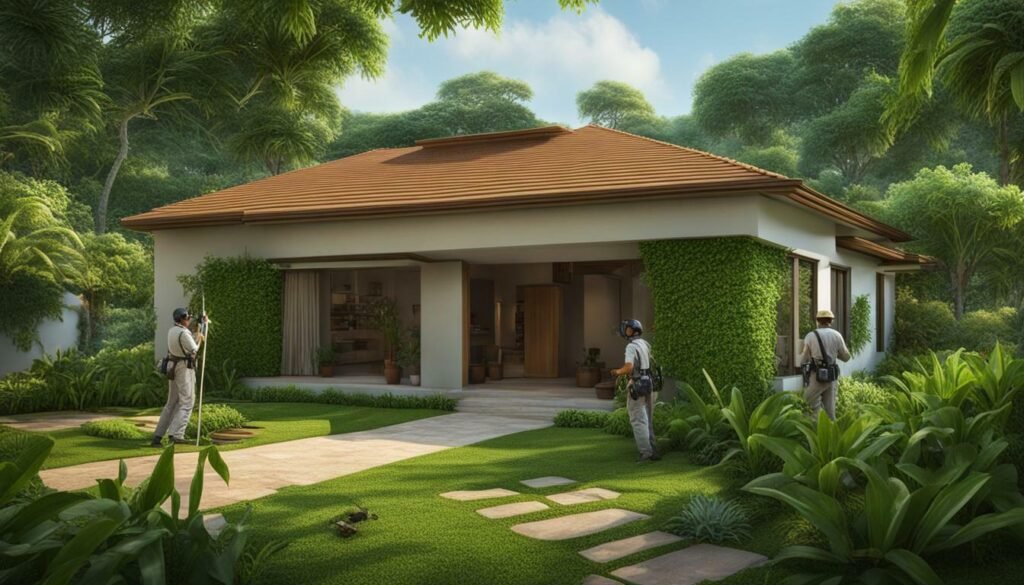Termite treatment is an essential step in protecting your home from these destructive pests. In this guide, we will walk you through what to expect during a professional termite treatment.
Key Takeaways:
- After a termite treatment, increased termite activity is common for the next 2-4 weeks, known as post-treatment termite swarm.
- Termites typically start dying within 1-2 days after treatment, but the time may vary based on the severity of the infestation.
- Signs that termites are gone include the absence of termite swarmers and continued mud tube activity.
- Properly applied termite treatments can last up to 5 years, but routine annual checks are still necessary.
- Preventive barriers and regular maintenance are crucial to prevent termites from returning after treatment.
Now that you know what to expect, let’s dive into the specific details of termite treatment in the following sections.
Signs of Termite Infestation
Before undergoing termite treatment, it is crucial to determine whether or not you have a termite infestation. Look out for these signs that may indicate the presence of termites in your home.
- Wood damage: Termites feed on wood from the inside out, leaving behind hollowed or damaged wood. Check for sagging floors, hollow-sounding wood, or the presence of small holes.
- Mud tubes: Subterranean termites create mud tubes as a means of travel between their colony and food sources. Look for muddy tunnels along the foundation of your home or crawling up walls.
- Swarmers: Winged termites, also known as swarmers, are reproductive termites that emerge in large numbers to establish new colonies. Spotting swarmers inside your home or finding discarded wings near windowsills is a clear indication of termites.
- Blisters in wood flooring: Sometimes, termites create blisters or bubbles on the surface of your wooden floors. These blisters are caused by termite activity beneath the surface.
- Tight-fitting doors and windows: As termites consume moisture from the wood, they can cause doors and windows to become difficult to open or close properly.
If you notice any of these signs, it’s important to have a professional termite inspection to confirm the presence of termites and assess the extent of the infestation. Remember, early detection can save you from costly repairs down the line.
Image:
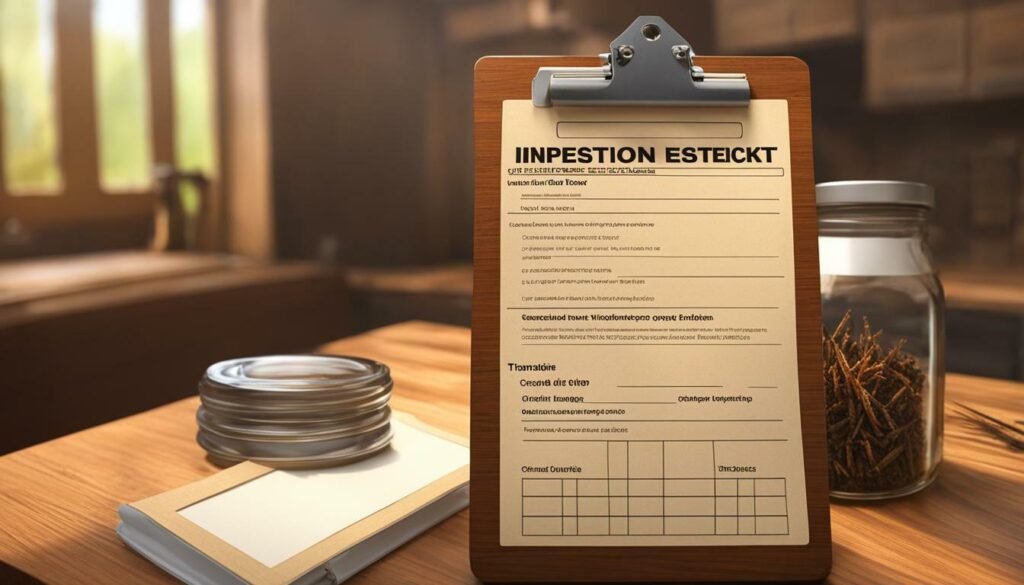

Termite Inspection Checklist
During a termite inspection, a trained professional will thoroughly examine your property for any signs of termite activity. Here are some key areas they will inspect:
| Areas to Inspect | What to Look For |
|---|---|
| Interior | Wood damage, mud tubes, swarmers, blistering in wood |
| Exterior | Mud tubes, damaged wood, termite shelter tubes, termite droppings |
| Crawl spaces and basements | Moisture issues, wood damage, mud tubes |
| Attic | Wood damage, termite shelter tubes, insulation damage |
| Foundation | Mud tubes, termite shelter tubes, damaged wood |
A comprehensive termite inspection will help determine the best course of action for termite treatment and prevention. Remember to consult a licensed professional to ensure the most effective and reliable results.
Remember, early detection is key to minimizing damage and protecting your home from further infestation. If you suspect a termite problem, don’t hesitate to seek professional assistance.
Termite Treatment Process
Once a termite infestation has been confirmed, the termite treatment process begins. Let’s explore each step involved in effectively eliminating termites from your home.
Step 1: Inspection
The first step in the termite treatment process is a thorough inspection of your property by a trained professional. This inspection helps identify the extent of the infestation and determine the most suitable treatment plan. During the inspection, the technician will look for signs of termite activity, such as mud tubes, damaged wood, and discarded wings. They may also use specialized equipment, such as moisture meters and thermal imaging cameras, to detect hidden termite colonies.
Step 2: Treatment Plan
After the inspection, the technician will develop a customized treatment plan based on the findings. The treatment plan will outline the recommended treatment methods and products to be used. Depending on the severity of the infestation, the treatment plan may include various approaches, such as liquid termiticides, termite baits, or fumigation. The technician will explain the options and help you choose the most effective solution for your specific situation.
Step 3: Treatment Application
Once the treatment plan is finalized, the technician will proceed with the application of the chosen treatment method. This may involve drilling and injecting termiticides into the soil around your home’s foundation, placing bait stations in strategic locations, or tenting and fumigating the entire structure. The application process will be carried out by trained professionals following industry standards to ensure the safety and effectiveness of the treatment.
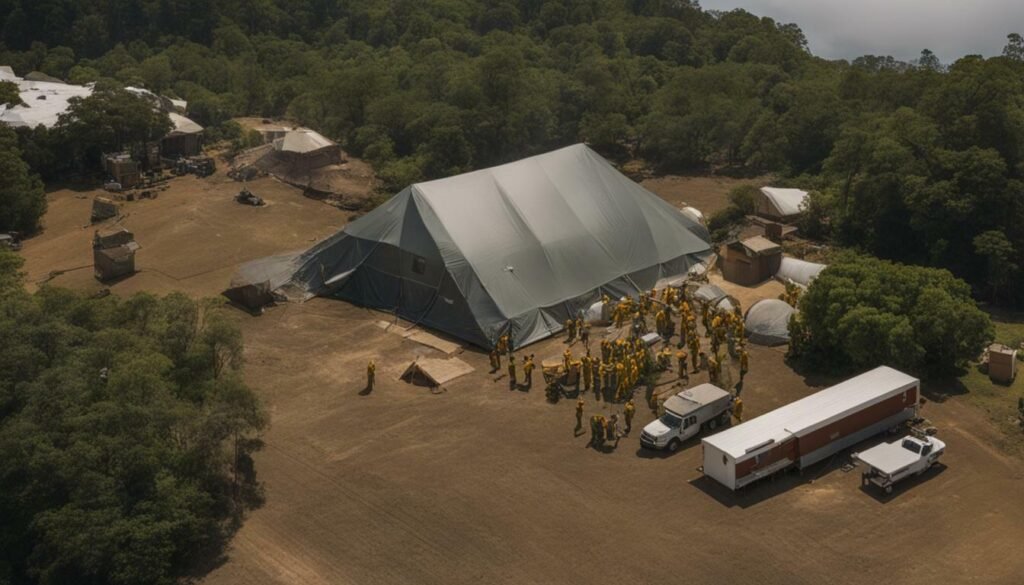

Step 4: Ongoing Maintenance
After the initial treatment, it is essential to implement ongoing maintenance to prevent future termite infestations. This may involve regular inspections to detect any new termite activity and the timely application of preventive treatments. The technician will provide guidance on how often inspections should be conducted and what preventive measures can be taken, such as sealing cracks and crevices, removing wood debris, and maintaining proper drainage around your property.
| Benefits of Professional Termite Control Services | DIY Termite Control |
|---|---|
|
|
“Choosing professional termite control services ensures that the treatment process is carried out correctly and efficiently, minimizing the risk of future infestations and potential structural damage to your property.”
By following these steps and relying on professional termite control services, you can effectively eliminate termites from your home and protect it from future infestations. Remember, early detection and regular maintenance are key to maintaining a termite-free environment.
Termite Treatment Cost
The cost of termite treatment can vary depending on several factors. Learn what influences the overall cost and get an idea of what to expect when budgeting for termite treatment.
When determining the cost of termite treatment, there are a few key factors to consider:
- The size of your property: Larger properties may require more extensive treatment, resulting in higher costs.
- The severity of the infestation: If the termite infestation is widespread and severe, it may require more intensive treatment methods, which can increase the cost.
- The type of treatment: Different treatment methods, such as liquid barrier treatments or baiting systems, have varying costs. Your pest control professional will recommend the most effective option based on your specific situation.
On average, homeowners can expect to spend between $1,500 and $3,000 for professional termite treatment. However, it’s important to note that this is just an estimate, and the actual cost will depend on the factors mentioned above.
Ultimately, investing in professional termite treatment is crucial for protecting your property from the devastating effects of termite damage. By addressing the issue promptly and working with a trusted pest control provider, you can minimize costs in the long run.
| Treatment Factors | Cost Range |
|---|---|
| Size of Property | $1,000 – $5,000+ |
| Severity of Infestation | $500 – $2,500 |
| Type of Treatment | $1,000 – $4,000 |
Understanding the Cost Breakdown
“When determining the cost of termite treatment, there are a few key factors to consider: the size of your property, the severity of the infestation, and the type of treatment.”
It’s essential to consult with a professional pest control company to get an accurate cost estimate tailored to your specific needs. They will conduct a thorough inspection of your property and provide you with a detailed quote outlining the treatment options and associated costs.
Remember, termite treatment is an investment in protecting your home and preventing costly repairs down the line. By prioritizing the eradication of termites and implementing preventive measures, you can maintain the structural integrity of your property and have peace of mind.


Termite Prevention Tips
Prevention is key when it comes to termites. Discover effective strategies and preventative measures to keep termites away from your home.
1. Remove wood debris: Termites are attracted to wood, so it’s important to keep your property clear of any wood debris, such as fallen tree branches or old lumber. Regularly clean your yard and dispose of any rotting wood.
2. Maintain proper ventilation: Termites thrive in damp environments, so it’s essential to keep your home well-ventilated. Ensure that basements, crawl spaces, and attics have proper airflow to prevent moisture buildup.
3. Fix leaks promptly: Termites are drawn to moisture, so addressing any plumbing leaks or water damage immediately is crucial. Check your pipes, faucets, and gutters regularly and repair any issues promptly.
4. Trim vegetation: Trim any trees, shrubs, or bushes that are in direct contact with your home. Termites can use these as bridges to access your property. Maintain a gap of at least one foot between vegetation and your home’s foundation.
5. Install termite barriers: Consider installing physical barriers, such as metal mesh or plastic sheeting, around your home’s foundation. These barriers can prevent termites from entering your property and provide an additional layer of protection.
Remember, prevention is always better than dealing with a termite infestation. By implementing these termite prevention tips, you can reduce the risk of termites damaging your home and save yourself from costly repairs in the long run.
| Termite Prevention Tips | Effectiveness |
|---|---|
| Remove wood debris | High |
| Maintain proper ventilation | High |
| Fix leaks promptly | High |
| Trim vegetation | Moderate |
| Install termite barriers | Moderate |
“Prevention is always better than dealing with a termite infestation.” – Termite Expert
Additional Tips for Termite Prevention
- Regularly inspect and seal any cracks or crevices in your home’s foundation.
- Keep firewood and mulch away from your home’s exterior.
- Have regular professional termite inspections to catch any signs of infestation early.
- Consider using termite-resistant building materials for new constructions or renovations.
By following these termite prevention tips and implementing preventative measures, you can protect your home from termites and ensure a termite-free environment for years to come.


Post-Treatment Termite Activity
After termite treatment, it is typical to experience increased termite activity, known as post-treatment termite swarm. We’ll explain why this happens and what it means for your home.
Termite treatments are designed to eliminate existing termite colonies and prevent new infestations. However, it takes time for the treatment to take full effect. Immediately after treatment, termites may become more active as they are disturbed by the chemicals used or are searching for new food sources.
This post-treatment termite swarm can last for up to 2-4 weeks. During this time, you may notice an increase in termite activity, including the presence of swarmers (winged termites) and an uptick in mud tube construction. While this may be unsettling, it is a normal part of the treatment process.
It’s important to remember that post-treatment termite swarm does not mean that the treatment was ineffective. In fact, it can be a sign that the treatment is working as intended, as it indicates that the termites are being affected by the treatment and are attempting to find new nesting sites. With time, the increased termite activity will diminish, and the population will decline until the infestation is eradicated.
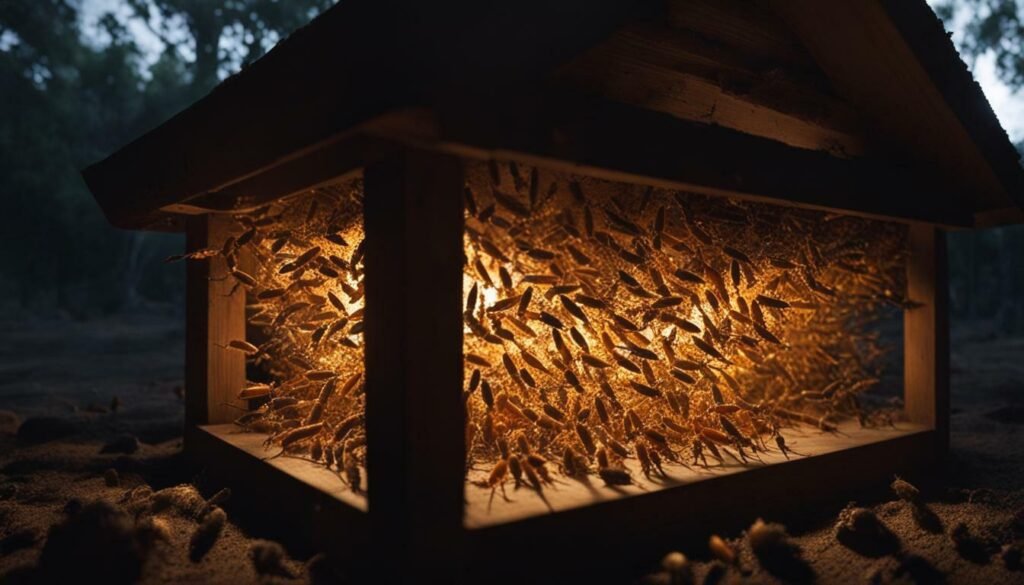

How to Deal with Post-Treatment Termite Swarm
While post-treatment termite swarm can be alarming, there are steps you can take to manage the situation:
- Do not disturb or attempt to remove the swarmers or mud tubes. Let the treatment work its course.
- Continue to monitor the affected areas for any signs of ongoing termite activity.
- If the increased termite activity persists beyond the expected timeframe or if you have any concerns, contact your termite control professional for guidance.
Remember, post-treatment termite swarm is a temporary occurrence and is a positive indication that the treatment is disrupting the termite colony. With proper treatment and ongoing maintenance, you can protect your home from termite infestations and ensure long-term termite-free living.
Termites After Treatment
While termite treatments can be highly effective, it’s important to take preventive measures to prevent future infestations. Discover how to keep termites from returning after treatment.
After a termite treatment, it is common to see increased termite activity for the next 2-4 weeks. This is called post-treatment termite swarm and is nothing to worry about. It typically takes 1-2 days for termites to start dying after treatment, but the time can vary depending on the severity of the infestation. Termites may become more active after treatment, and it is not uncommon to see increased termite activity for up to 4 weeks.
Signs that termites are gone include the absence of termite swarmers and continued mud tube activity. Destroying part of the mud tubes and seeing if termites repair the damage can also be an indicator. Termite treatments can last up to 5 years if applied properly, but routine annual checks should still be done. Termites can come back after treatment, so preventive barriers should be installed to prevent re-entry. Regular checks and maintenance are essential to detect new colonies early.
After termite fumigation, you may see other pests that snuck into the home to feed on dead termite colonies. Termite droppings and a few termites may also be present, but they will eventually die off. Treating the surroundings of the property is important to prevent further infestation from subterranean termites and those in surrounding trees.
| Post-Treatment Tips: |
|---|
| 1. Monitor termite activity for several weeks after treatment. |
| 2. Seal any cracks or entry points that may attract termites. |
| 3. Remove any wood debris or moisture sources near your home. |
| 4. Consider installing a termite monitoring system for early detection. |
Remember:
While termites are active in your area and can cause significant damage to your home, there are effective treatment options available. By taking proactive measures and working with a professional termite control service, you can ensure long-term protection for your property.


Duration and Maintenance of Termite Treatment
Termite treatments can provide long-lasting protection, but regular maintenance is crucial to keep your home termite-free. It’s important to understand how often you should check for termites and maintain your treatment to ensure the best results.
Once a termite treatment has been performed, it typically takes 1-2 days for the termites to start dying off. However, the timeframe may vary depending on the severity of the infestation. In the weeks following the treatment, it is common to see increased termite activity. This post-treatment termite swarm is a normal part of the process and should not cause alarm.
To determine if the termites are gone, look for signs such as the absence of termite swarmers and continued mud tube activity. You can also try destroying part of the mud tube and observing if the termites repair the damage. These indicators can help confirm the effectiveness of the treatment.
While termite treatments can provide protection for up to 5 years when applied properly, routine maintenance is essential. Regular annual checks should be conducted to detect any new colonies or signs of termite activity early on. By staying proactive and addressing any potential issues promptly, you can maintain a termite-free home and avoid costly damage.
Table: Termite Treatment Duration and Maintenance
| Duration | Maintenance |
|---|---|
| 1-2 days for termites to start dying after treatment | Regular annual checks for new colonies or signs of activity |
| Increased termite activity for up to 4 weeks | Promptly address any potential issues |
| Termite treatments can last up to 5 years | Stay proactive to maintain a termite-free home |
Remember, while termite treatments can be highly effective, they are not foolproof. Termites can come back, which is why preventive measures are crucial. Installing barriers to prevent re-entry and conducting regular checks and maintenance will help ensure long-term protection against termites.


Other Pests and Termite Fumigation
After termite fumigation, it’s not uncommon to encounter other pests in your home. We’ll explain why this happens and provide reassurance that it’s a temporary situation.
When a termite infestation is severe and requires fumigation, it involves the use of powerful chemicals to eliminate the termites. These chemicals are also effective against other pests that may be present in your home, such as ants, cockroaches, or spiders. During and after fumigation, these pests may become disoriented and emerge from their hiding spots in search of food and water. This sudden increase in activity can be alarming, but rest assured that it is only temporary.
To further ensure the effectiveness of the fumigation, some dead termites may be left behind. Their presence may attract other insects that feed on corpses, such as carpet beetles or dermestid beetles. These beetles are harmless and will eventually die off once the food source is exhausted.
In addition, you may also notice some termite droppings, known as frass, after fumigation. This is a sign that the termites have consumed the treated wood and are being eliminated. As the termites die off, the frass will decrease and eventually disappear.
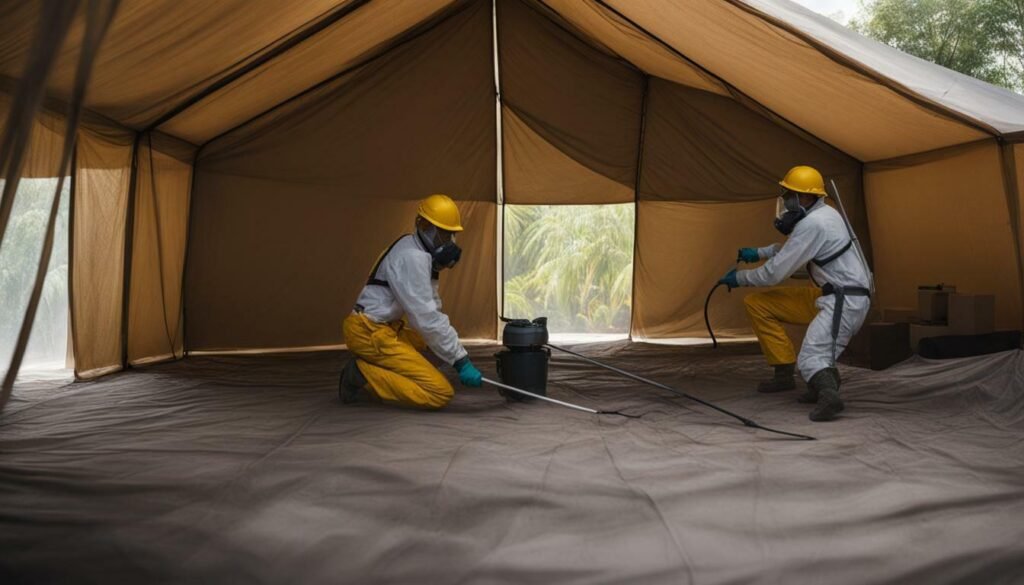

Treating the surroundings
It’s important to note that fumigation primarily targets the termites within the structure of your home. To prevent reinfestation and protect your property, it’s crucial to address the surrounding areas as well. Subterranean termites, for example, can still pose a threat if they have access to the soil around your home or neighboring trees.
To prevent further infestation, consider installing preventive barriers, such as chemical treatments or physical barriers like metal mesh, around the perimeter of your home. This will create a barrier that termites cannot cross, ensuring long-term protection. Regular checks and maintenance are also essential in detecting any new termite colonies early and taking swift action to prevent further damage.
Remember, encountering other pests after termite fumigation is a normal part of the process. With proper treatment, routine maintenance, and preventive measures, you can ensure your home remains termite-free and protected for years to come.
Conclusion
By understanding the termite treatment process, signs of infestation, and preventative measures, you can safeguard your home from termite damage. Remember to seek professional termite control services and implement preventive strategies to ensure a termite-free environment.
After a termite treatment, it is common to see increased termite activity for the next 2-4 weeks. This is called post-treatment termite swarm and is nothing to worry about. It typically takes 1-2 days for termites to start dying after treatment, but the time can vary depending on the severity of the infestation. Termites may become more active after treatment, and it is not uncommon to see increased termite activity for up to 4 weeks.
Signs that termites are gone include the absence of termite swarmers and continued mud tube activity. Destroying part of the mud tubes and seeing if termites repair the damage can also be an indicator. Termite treatments can last up to 5 years if applied properly, but routine annual checks should still be done. Termites can come back after treatment, so preventive barriers should be installed to prevent re-entry. Regular checks and maintenance are essential to detect new colonies early.
After termite fumigation, you may see other pests that snuck into the home to feed on dead termite colonies. Termite droppings and a few termites may also be present, but they will eventually die off. Treating the surroundings of the property is important to prevent further infestation from subterranean termites and those in surrounding trees.
FAQ
Q: What should I expect after a termite treatment?
A: It is common to see increased termite activity for the next 2-4 weeks, known as post-treatment termite swarm. This is nothing to worry about and is part of the treatment process.
Q: How long does it take for termites to start dying after treatment?
A: It typically takes 1-2 days for termites to start dying after treatment. However, the time can vary depending on the severity of the infestation.
Q: Will termites become more active after treatment?
A: Yes, it is possible for termites to become more active after treatment. Increased termite activity for up to 4 weeks is not uncommon.
Q: How can I tell if termites are gone after treatment?
A: Signs that termites are gone include the absence of termite swarmers and continued mud tube activity. Destroying part of the mud tubes and seeing if termites repair the damage can also be an indicator.
Q: How long does termite treatment last?
A: Termite treatments can last up to 5 years if applied properly. However, routine annual checks should still be done to ensure ongoing protection.
Q: Can termites come back after treatment?
A: Yes, termites can come back after treatment. To prevent re-entry, preventive barriers should be installed, and regular checks and maintenance are essential to detect new colonies early.
Q: What can I expect after termite fumigation?
A: After termite fumigation, you may see other pests that snuck into the home to feed on dead termite colonies. Termite droppings and a few termites may also be present, but they will eventually die off.
Q: How important is treating the surroundings of the property?
A: Treating the surroundings of the property is crucial to prevent further infestation from subterranean termites and those in surrounding trees.
Source Links
- https://www.mugabugpestcontrol.com/subterranean-termite-treatments/
- https://www.thepestinformer.com/pest-guides/termites/what-to-expect-after-a-termite-treatment/
- https://florida-environmental.com/everything-you-need-to-know-about-post-termite-treatment/
Your Expert in Animal Control and Extermination. Trust our experience for humane, effective pest management, protecting your property and ensuring peace of mind with Michael S.

